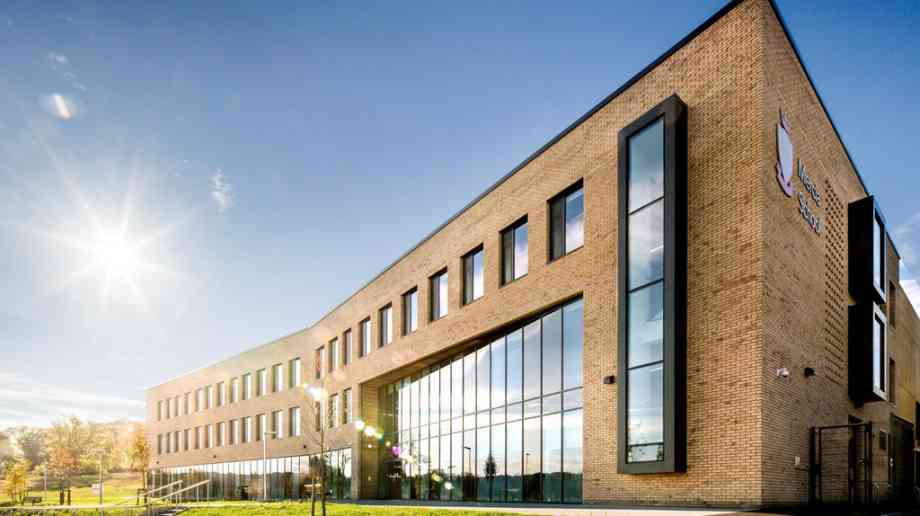
The ten-year rebuilding programme for schools
Image shows Mercia School, credit Phil Grayston
Good design must be made a priority in deciding how the government’s new investment into school buildings is spent, writes the Royal Institute of British Architects’s Client Advisers
In June 2020, the government announced £1billion of investment for schools. This ten-year investment programme is the first significant wave of funding launched since 2014. As a result, it needs to both play catch-up and forecast future needs.
We know that new school buildings help deliver better educational outcomes, tackle wider societal issues such as the climate emergency and act as community hubs. This isn’t an accident; working with the right team can help to dramatically raise the chances of success.
A Royal Institute of British Architects (RIBA) Client Adviser can work with schools to guarantee that the right questions are asked and the appropriate guidance is given at every stage of the building programme, helping to ensure that the needs of the students and teachers are at the centre of the project and that sustainability is considered throughout.
The best prepared projects have the best chances of success
Sustainable design is a collaborative endeavour. Bringing together design professionals, clients, contractors and most importantly the building’s guardians, its teachers and children is key to success.
Architects are ready to take the lead. We have a wealth of professional expertise in school design which we have demonstrated over the last two decades. The profession’s progressive and continuous development on sustainability and environmental design also puts us in good stead to take a holistic, whole-life approach to this new phase of school projects.
The value of good design
We know that schools play a vital role in influencing our children’s outlook and life chances – from academic learning to social skills – they help shape us into the adults we grow into and the communities we are a part of.
The Royal Institute of British Architects’ Better Spaces for Learning report, published in 2016, demonstrates that good design must be made a priority in deciding how this new investment fund is spent.
Our research highlights the important role that good design plays in the efficacy of a school for both the pupils, their families and staff. This research indicates that good design, which includes good quality natural light, good acoustics, flexible spaces and simple, natural ventilation systems, has been proven to positively impact pupil behaviour, engagement, wellbeing and attainment. It also indicates that good design improves school staff’s productivity, with the most comfortable and well-designed schools demonstrating a 15 per cent increase in this area.
In addition to improving educational outcomes, good design makes good business sense – well-designed schools are cheaper to run. According to our research in 2016, an excess of £150 million is being spent annually on services and maintenance. Such additional expenditure could be avoided in the future by having a more holistic and coordinated approach that includes robust briefing in the design process of new schools.
Crucially though, good design of school buildings must encompass sustainability and work to address the climate emergency. It should aim to reduce the environmental impact of the building through both the energy consumed during construction and once in use.
The role of architects in helping to tackle the climate emergency
Understanding and ensuring good, sustainable design in schools is where the role of an RIBA Chartered Architect and particularly, an RIBA Client Adviser can be extremely beneficial.
Sustainable design can be complex and what works on one site may be unsuitable for another. Each project has to balance the effective allocation of site and resources, alongside the school’s long-term operations objectives. Warmer summer weather presents a significant challenge for designers. A good team will consider key factors including natural ventilation with openable windows, sufficient room height and depth, effective layout of classrooms and corridors, and good daylight, while taking into account the room’s orientation.
Taking a holistic approach to design, sustainability and user wellbeing will help save money in the long term. This could be through more energy efficient buildings which reduces energy costs, greater utilisation of internal and external spaces, and by making it easier to attract and retain the best teachers- according to our research, 20 per cent of teachers have considered quitting because of the current condition of school buildings.
Modern methods of construction
Recently the use of Modern Methods of Construction (MMC) has gained attention in both the public and private sector. Rather than building from scratch on a building site, using MMC, parts are built under factory conditions and shipped to site for assembly. The RIBA believes that MMC has the potential to become increasingly cost and time efficient as the technology develops. For schools where onsite construction can present particular disruption and safety challenges, this has the potential to be a game changer.
MMC provides the opportunity to facilitate a step change in how we build schools and for holistic design governance. This is useful in schools where standard designs can be appropriately adapted to meet the client’s requirements. Here, the role of a RIBA Client Adviser can be incredibly useful. They can be your advocate, understanding the needs of the school, defining a clear brief and appraising advantages between standardisation and contextualised design, utilising MMC where it is most effective.
Ensuring design quality
To continuously improve our schools, we must use the lessons learned from schools already built and in use. What worked on paper during the design process does not always prove as effective when up and running. To avoid repeating this performance gap, a well-structured and comprehensive assessment of existing school buildings, through Post Occupancy Evaluation (POE) is essential.
POE is the process of obtaining feedback on a building’s performance in use after it has been built and occupied. Capturing lessons learnt and sharing these in a structured way will help ensure that continuous improvement and best practice are informing ongoing and new projects. The information collected and the feedback loop is especially valuable in assessing how energy can be better managed.
Latest News
09/01/2026 - 10:13
The measure, added to the Children’s Wellbeing and Schools Bill, delivers on the commitment made in the government’s manifesto to bring multi academy trusts into the inspection system.
08/01/2026 - 10:30
The government is launching a new app allowing students to view their GCSE results on their phones for the first time from this summer.
08/01/2026 - 09:45
Education Business LIVE has announced that Professor Samantha Twiselton OBE of Sheffield Hallam University will speak at the event in March 2026, delivering two thought-provoking sessions focused on initial teacher training and SEND provision.
07/01/2026 - 10:10
Solve for Tomorrow is a free, curriculum-linked programme which is mapped to Gatsby Benchmarks 4, 5, and 6, helping teachers embed careers education without adding to workload.
06/01/2026 - 10:24
London's universal free school meals programme has not led to improvements in pupil attainment during its first year, but has eased financial pressure and reduced stress for families.







